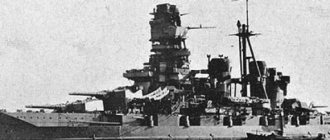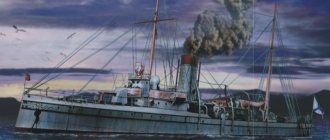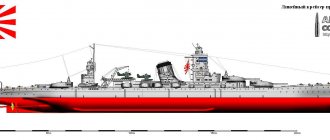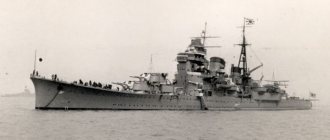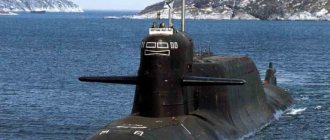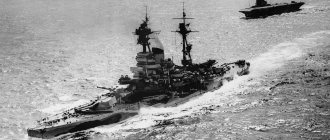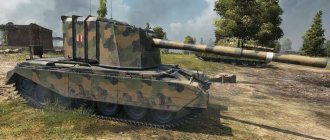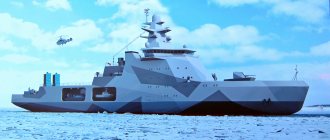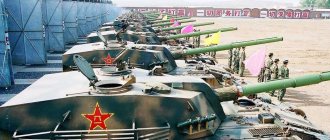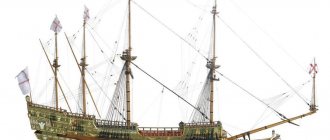History of the creation of Asama-class armored cruisers
Initially, the very concept of “cruiser” assumed a very specific role in naval warfare. The cruiser’s task is to “stand” on the enemy’s sea communications and nullify his maritime trade. Accordingly, the ideal cruiser has good seaworthiness, high autonomy, it is armed enough to sink an armed merchant ship or destroyer in a naval battle, and is fast enough to “escape” from any dangerous pursuer. A cruiser is a long-range reconnaissance vehicle and, if you like, a “corsair”. A ship of this type does not even need serious armor - its tasks are completely different.
From this point of view, the Japanese cruisers Asama and Tokiwa look like some kind of antipodes to established traditions. Not very seaworthy and autonomous, these ships were armed with huge (by cruising standards) 203-mm guns and carried armor that gave them the ability to fight as part of a squadron of battleships, without the risk of sinking from a close explosion of a 305-mm shell. The thing is that “Asama” and “Tokiwa” really weren’t exactly cruisers... they were cruiser hunters.
If the main task of the classic cruiser was to hunt “merchants”, then “Asama” hunted the sea hunters themselves, and also provided support to “senior comrades” - battleships in squadron battle. It is curious that if we directly consider the armoring scheme of the Asama and its sistership, an obvious detail immediately catches the eye: in terms of the placement of the armor belt, its thickness and length, the Asama is more of a “small battleship” than a “large cruiser.” Japanese admirals also thought so.
The Asama class cruiser project was created by the English shipbuilder Philip Watts based on the design of the Chilean cruiser O'Higgins, but with better protection, more powerful and better located weapons. "Asama" became one of the last and most powerful English "Elswick" cruisers - a huge family of "export" English cruisers built mainly for not the richest, but very ambitious customers. And it should be noted that the designers managed to create a truly unique project in many respects - to create a ship similar in armament and armor to battleships, and in speed not inferior to “ordinary” cruisers - many people strived for this, but they were the first to achieve such results in practice, perhaps specifically the British.
As already mentioned, unlike the armored cruisers of other maritime powers, which were intended for operations on trade routes and long-range reconnaissance, the main task of Japanese ships was to participate in squadron battles along with battleships. In fact, it was the Asama and others like it that were the forerunners of the battlecruisers - the high-speed wing of the fleet in the squadron battle of dreadnought battleships, which appeared shortly after the end of the Russo-Japanese War.
The main caliber of the Asama is a turret with two 203 mm guns
Links[edit]
- Brook, Peter (2000). "Armored Cruiser vs. Armored Cruiser: Ulsan, August 14, 1904." In Preston, Anthony (ed.). Warship 2000–2001
. London: Conway Maritime Press. ISBN 0-85177-791-0. - Campbell, N. J. (1978). "Battle of Tsu-Shima, parts 2, 3 and 4." In Preston, Anthony (ed.). Warship
.
II
. London: Conway Maritime Press. pp. 127–35, 186–192, 258–65. ISBN 0-87021-976-6. - Chesneau, Roger, ed. (1980). Conway's Fighting Ships of the World 1922–1946
. Greenwich, UK: Conway Maritime Press. ISBN 0-85177-146-7. - Chesneau, Roger & Kolesnik, Eugene M., eds. (1979). All of Conway's World's Warships 1860–1905. Greenwich: Conway Maritime Press. ISBN 0-8317-0302-4.
- Corbett, Julian Stafford (1994). Naval operations in the Russo-Japanese War, 1904–1905
. Annapolis, MD: Naval Institute Press. ISBN 1-55750-129-7. - Evans, David & Peattie, Mark R. (1997). Kaigun: Strategy, Tactics and Technology in the Imperial Japanese Navy, 1887–1941
. Annapolis, MD: Naval Institute Press. ISBN 0-87021-192-7. - Forczyk, Robert (2009). Russian battleship versus Japanese battleship, Yellow Sea 1904–05
. Botley, UK: Osprey. ISBN 978-1-84603-330-8. - Friedman, Norman (2011). Naval weapons of the First World War
. Barnsley, South Yorkshire, UK: Seaforth. ISBN 978-1-84832-100-7. - Jentschura, Hansgeorg; Jung, Dieter and Mikel, Peter (1977). Warships of the Imperial Japanese Navy, 1869–1945
. Annapolis, MD: United States Naval Institute. ISBN 0-87021-893-X. - Kauner, Rotem (2006). Historical Dictionary of the Russo-Japanese War
.
Historical dictionaries of war, revolution and civil unrest. 29
. Lanham, MD: Scarecrow Press. ISBN 978-0-81084-927-3. - Lacroix, Eric and Wells, Linton (1997). Japanese cruisers of the Pacific War
. Annapolis, MD: Naval Institute Press. ISBN 0-87021-311-3. - Milanovic, Katrin (2014). "Armored cruisers of the Imperial Japanese Navy." In Jordan, John (ed.). Warship 2014
. London: Conway. ISBN 978-1-84486-236-8. - Silverstone, Paul H. (1984). Directory of the World's Capital Ships
. New York: Hippocrene Books. ISBN 0-88254-979-0. - Wells, Benjamin (1997). Sumner Welles: Roosevelt's Global Strategist: A Biography. Palgrave Macmillan. ISBN 0-312-17440-3.
Design of Asama-class armored cruisers
The main feature of the Japanese cruisers Asama and Tokiwa was their armor: the main armor belt in length reached 66% of the length of the ship, and the thickness ranged from 178 mm (in the center) to 89 mm (at the ends). For comparison: for the most powerful Japanese squadron battleship Mikasa, these figures were: 50% with a thickness of 178-229 mm. Not bad for a cruiser, right?
The horizontal protection of the cruiser citadel was provided by a carapace armored deck, the thickness of which at the bevels reached 51 mm; the same bevels provided additional protection for the extremities. An important addition was the second (upper) armor belt with a thickness of 127 mm, which, together with 152 mm traverses, provided reliable protection for casemate artillery. The main caliber turrets and their barbettes were covered with 152 mm armor; the armor of the bow torpedo tube compartment was the same thickness.
The conning tower had the most impressive protection: up to 356 mm, and besides, the conning tower’s shape virtually eliminated accidental damage to people inside it by shrapnel. This made it possible to guarantee the preservation of control of the ship in any circumstances and eliminated the need to create reserve control posts. The total armor weight reached 22% of the displacement, while only about 40% of the ship's area remained unarmored.
Drawing of armored cruisers: "Asama" and "Tokiwa"
These cruisers showed full speed during a 4-hour run with forced thrust. The actual continuous speed was 19-19.5 knots.
The relatively short cruising range and low seaworthiness are partly explained by the cruisers' design for operations in a closed theater. Placing part of the medium artillery in casemates below the upper deck with a low freeboard could make it impossible to fire from them in rough seas. This was later confirmed during World War I at the Battle of Cape Coronel, when British armored cruisers with a similar artillery arrangement could not fire from the guns of the lower casemates.
The armament of the Asama-class cruisers consisted of 4 203 mm (8 inch) guns in twin turrets at the bow and stern. The ammunition for the main caliber turrets was located directly in the turrets themselves (80 rounds per gun). Although this jeopardized the safety of the entire cruiser in the event of an armor-piercing hit in the turret, at the same time it made it possible to achieve a good rate of fire, reaching three rounds per minute.
The intermediate caliber was represented by 14 Armstrong 152 mm quick-firing guns (150 rounds per barrel). 10 such guns were located in a casemate (5 guns on each side), another 4 in deck installations protected by anti-fragmentation shields.
The anti-mine caliber consisted of 12 76 mm caliber guns (on the upper and battery decks, as well as on the bridge wings) and 8 47 mm caliber Hotchkiss guns. The cruisers also had 5 torpedo tubes (4 underwater and 1 surface).
Footnotes [edit]
- ↑
Evans & Peattie, pp. 57–62. - ↑
Milanovic, s. 72 - ↑
Milanovic, pp. 74, 80 - ^ ab Jentschura, Jung & Mickel, page 73
- ↑
Milanovic, s. 81 years old - Jentschura, Jung and Mikel, pp. 73-74
- ↑
Milanovic, pp. 76–77. - ^ a b Milanovic, p. 78
- Friedman, p. 276; Milanovic, s. 78
- Friedman, p. 114
- ↑
Milanovic, s. 80 - ↑
Milanovic, pp. 80–81. - Chenault and Kolesnik, p. 225
- Silverstone, page 326
- ↑
Milanovic, s. 73 - Kowner, page 125
- Corbett, II, p. 153
- Kowner, page 465
- Forczyk, pp. 42-43
- Corbett, I, p. 105
- Corbett, I, pp. 138-39, 142-45, 160, 177, 188-89, 191-96
- Corbett, I, pp. 283-89, 319-25, 337-51
- Jump up
↑ Brook, pp. 34, 37 - Jump up
↑ Brook, pp. 39, 43 - ^ab Brook, page 43
- Jump up
↑ Brook, pp. 43, 45 - Jump up
↑ Corbett, II, pp. 153, 162 - Jump up
↑ Corbett, II, pp. 232, 235 - Campbell, part 2, pp. 128-32
- Campbell, part 3, pp. 186-87
- Corbett, II, pp. 319-20
- ↑
Campbell, Part 4, page 263 - Corbett, II, p. 357
- Lacroix & Wells, pp. 552, 656-59
- Wells, p. 49
- Jump up
↑ Lacroix & Wells, pp. 657, 659 - ^ ab Lacroix & Wells, page 659
- ^ab Chenault, page 174
Characteristics
A country:Type:Year of issue:Crew:Engine:Maximum speed:Practical ceiling:Range of flight:Empty weight:Maximum take-off weight:Wingspan:Length:Height:Wing area:Weapons:
Service history of Asama-class armored cruisers
Armored cruiser "Asama"
Laid down November 1896, launched March 23, 1898, completed March 18, 1899 (England)
On February 9, 1904, “Asama” was the “main caliber” of the Japanese squadron that attacked the Russian cruiser “Varyag” and the gunboat “Koreets” in the roadstead of the Korean Chemulpo. Even without taking into account the other 5 Japanese cruisers, one Asama would have been enough to destroy the Varyag, whose armor belt was not even penetrated by the Varyag’s shells. 3 hits from the Asama were the most sensitive for the Russian cruiser. In response, according to Russian data, the rear bridge of the Asama was destroyed and a fire broke out, but the Japanese side does not confirm this information.
Subsequently, throughout 1904, Asama operated near Port Arthur, took part in the battle in the Yellow Sea on July 28, 1904, where it was damaged by fire from the cruiser Askold.
Seriously suffered in the Battle of Tsushima, where at certain moments of the battle he was forced to serve as a flagship. Received 12 hits from the battleship "Emperor Nicholas I" (3 - 305 mm, 2 - 254 mm), temporarily left the battle to repair damage, including the steering mechanism, and had extensive flooding. In total, he “fell out” of the battle for about three hours.
She served as an auxiliary warship until the 1920s.
Since 1921, reclassified as a coastal defense ship, partially disarmed (4x203, 4x152, 2x80 zen., 2x450 mm TA). Since 1937 - a training ship.
Excluded from the lists of the fleet and dismantled for metal in 1947.
Japanese cruiser Asama on a courtesy visit to Boston, USA. Post-war photograph (1917 or 1927)
